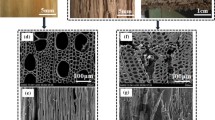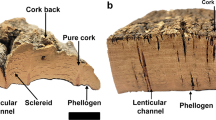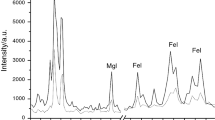Abstract
We explored the discoloration of rattan cane using X-ray photoelectron spectroscopy (XPS) and Fourier transform infrared spectroscopy (FTIR). XPS analysis showed that after the cane was stained by Lasiodiplodia theobromae, carbon and oxygen elements and the ratio of oxygen to carbon decreased. Considering atomic binding, C1 and C4 contents increased, while C2 and C3 contents decreased, and the ratio of O2 to O1 decreased sharply. The relative contents of lignin, cellulose and polysaccharides increased and new substances with low O2/O1 ratio occurred. FTIR analysis showed that the absorption peaks of O–H at 3346 cm−1, aliphatic C–H at 2921, 2853 and 1464 cm−1, and C=O at 1723 cm−1, were characteristic peaks of fungal melanin intensified, indicating that cane discoloration was primarily caused by fungal melanin. The absorption peaks characterizing cellulose and lignin like polysaccharides at 800 cm−1, C–H at 1374 cm−1, C–O at 1058 and 1038 cm−1, phenolic hydroxyl at 1245 cm−1, aromatic ether bonds at 1270 cm−1, carbon skeleton at 1608 cm−1 and benzene ring at 1500 cm−1 were enhanced since the fungus mainly consumed the extractives in cane cell lumens and the main composition content increased relatively. Regardless of the discoloration caused by natural fungi or inoculated fungi, the discoloring feature and composition changes were identical except that the fungus-inoculated cane had more melanin.


Similar content being viewed by others
References
Abasolo WP, Yoshida M, Yamamoto H (2003) Thermal softening of rattan canes: influence of the hemi cellulose-lignin matrix. World Bamboo Rattan 1(4):32–36
Amardeep SS, Jose SM (2013) Biosorption of uranium by melanin: kinetic, equilibrium and thermodynamic studies. J Bioresour Technol 149:155–162
Barry AO, Koran Z, Kaliaguine S (1990) Surface analysis by ESCA of sulfite post-treated CTMP. J Appl Polym Sci 39(1):31–42
Ed DJ, Richard PC, John NS (1997) Effects of a fungal treatment on the brightness and strength properties of a mechanical pulp from Douglas-fir. Bioresour Technol 61(1):61–68
Jiang ZH (2007) Bamboo and rattan in the world. China Forestry Publishing House, Beijing
Jiang ZH, Lv WH, Ren HQ, Fei BH, Wu YZ (2007) Review on rattan cane properties. World For Res 20(4):35–40
Ju XH, Mark E, Zhang X (2013) An advanced understanding of the specific effects of xylan and surface lignin contents on enzymatic hydrolysis of lignocellulosic biomass. Bioresour Technol 132:137–145
Lü WH, Xiao SQ, Mu QY (2002) Main causes of Betula alnoides wood’s discoloration. J Beijing For Univ 24(4):107–110
Lü WH, Jiang ZH, Wu YZ (2009) Basic components and chemical properties of the cane of Daemonorops margaritae. Sci Silvae Sin 45(7):96–100
Lü WH, Liu XE, Liu JL (2011) Fungal staining of Daemonorops margaritae canes. Sci Silvae Sin 47(8):196–200
Lü WH, Jiang ZH, Liu XE, Liu JL (2013) Causes and removal of Daemonorops margaritae cane’s discoloration. Adv Mater Res 634–638:909–912
Ozen E, Yeniocak M, Goktas O, Alma HM, Yilmaz F (2014) Antimicrobial and antifungal properties of madder root (Rubia tinctorum) colorant used as an environmentally-friendly wood preservative. Bioresources 9(2):1998–2009
Peters CM, Thammavong B, Mekaloun B, Phearoom N, Ratanak O, Ledecq T (2013) Growth of wild rattans in Cambodia and Laos: implications for management. For Ecol Manag 306:23–30
Sernek M, Kamke FA, Glasser WG (2004) Comparative analysis of inactivated wood surfaces. Holzforschung 58(1):22–31
Shi BZ, Wang WH (1992) ESR analysis of fungus stained-wood. Sci Silvae Sin 28(4):330–335
Sinn G, Gindl M, Reiterer A, Tschegg SS (2004) Changes in the surface properties of wood due to sanding. Holzforschung 58(3):246–251
Wang XQ, Fei BH, Ren HQ (2009) FTIR spectroscopic studies of the photo-discoloration of Chinese Fir. Spectrosc Spectr Anal 29(5):1272–1275
Widayati AJ, Samantha CB (2010) Accessibility factors and conservation forest designation affecting rattan cane harvesting in Lambusango Forest, Buton, Indonesia. Hum Ecol 38(6):731–746
Zheng L, Wu XQ (2007) Advances on infection structures of plant pathogenic fungi. J Nanjing For Univ Nat Sci 31(1):90–94
Author information
Authors and Affiliations
Corresponding author
Additional information
Project Funding: This study was supported by the National Key Project of S & T Supporting Programs Funded by MOST of China during the 12th Five-year Plan (No. 2012BAD23B0104).
The online version is available at http://www.springerlink.com
Corresponding editor: Yu Lei.
Rights and permissions
About this article
Cite this article
Lyu, W., Shi, Y., Zheng, Y. et al. XPS and FTIR studies of fungus-stained Daemonorops margaritae. J. For. Res. 30, 739–743 (2019). https://doi.org/10.1007/s11676-018-0598-5
Received:
Accepted:
Published:
Issue Date:
DOI: https://doi.org/10.1007/s11676-018-0598-5




